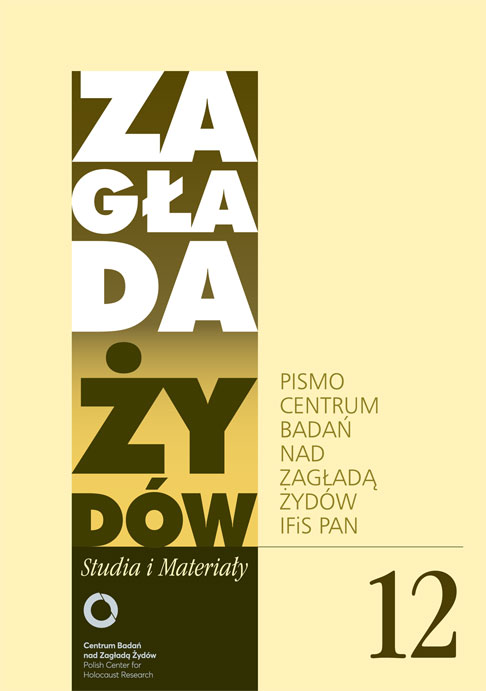Zagłada jako horror. Kilka uwag o literaturze polskiej 1985–2015
Zagłada Żydów. Studia i Materiały, Nr 12 (2016), Strony: 375-394
Data zgłoszenia: 2020-10-20Data publikacji: 2016-11-30
 https://doi.org/10.32927/ZZSiM.423
https://doi.org/10.32927/ZZSiM.423
Abstrakt
The author suggests that the depictions of the Holocaust in Polish literature of 1918–2014 should be categorized as horror. From the chronological perspective, Czapliński divides those thirty years into three shorter periods: 1) the initial period (from Claude Lanzmann’s Shoah and Jan Błoński’s essay “The Poor Poles Look at the Ghetto” to Wilhelm Dichter’s and Michał Głowiński’s memoirs) was dominated by white horror, which presented Jews as ghosts demanding a place in the Polish memory; 2) during the second period (from Marek Bieńczyk’s Tworki and Jan Tomasz Gross’ Neighbors until the end of the 2010s) the horror poetics was used to reveal those principles of pre-war and occupation-period normality which helped the Germans conduct the Holocaust and which conditioned the exclusion of Jews from the Polish circle of ‘normal humanity’; 3) during the third period (from Gross’s Golden Harvest until now) Jews return as the undead, violating the rules of distance and obliging Poles to physically touch the disgusting topic of the Holocaust. The contact with the Holocaust as something abhorring becomes a condition for self-knowledge, purging, and establishment of a new imaginary community.
Słowa kluczowe
Zagłada , horror , groza , obrzydliwość
Licencja
Prawa autorskie (c) 2016 Autor&"Zagłada Żydów. Studia i Materiały"

Utwór dostępny jest na licencji Creative Commons Uznanie autorstwa 4.0 Międzynarodowe.
https://creativecommons.org/licenses/by/4.0
Czasopismo publikowane jest w standardzie Diamond Open Access na licencji CC-BY-4.0 Deed - Uznanie autorstwa 4.0 Międzynarodowa - Creative Commons
Inne teksty tego samego autora
- Przemysław Czapliński, The Auschwitz Virus , Zagłada Żydów. Studia i Materiały: Nr Holocaust Studies and Materials (2017)
- Przemysław Czapliński, Prawda i co dalej , Zagłada Żydów. Studia i Materiały: Nr 15 (2019)
- Przemysław Czapliński, Wirus Auschwitz , Zagłada Żydów. Studia i Materiały: Nr 10 (2014)
Podobne artykuły
- Ewa Wiatr, Kawalerowie Krzyża Żelaznego w getcie łódzkim , Zagłada Żydów. Studia i Materiały: Nr 8 (2012)
- Adam Sitarek, W obliczu „trudnej konieczności”. Administracja żydowska getta łódzkiego wobec wsiedleń Żydów z Rzeszy i Protektoratu (październik–listopad 1941 r.) , Zagłada Żydów. Studia i Materiały: Nr 8 (2012)
- Karolina Panz, “Why did they, who had suffered so much and endured, had to die?” The Jewish victims of armed violence in Podhale (1945–1947) , Zagłada Żydów. Studia i Materiały: Nr Holocaust Studies and Materials (2017)
- Redakcja, Od Redakcji , Zagłada Żydów. Studia i Materiały: Nr 21 (2025)
- Marta Tomczok, Literatura polska wobec Zagłady 2000 – 2024. Bilans subiektywny , Zagłada Żydów. Studia i Materiały: Nr 20 (2024)
- Piotr Forecki, Do Europy tak, ale razem z naszymi syjonistami , Zagłada Żydów. Studia i Materiały: Nr 21 (2025)
- Dariusz Libionka, Polskie piśmiennictwo na temat zorganizowanej i indywidualnej pomocy Żydom (1945–2008) , Zagłada Żydów. Studia i Materiały: Nr 4 (2008)
- Renata Piątkowska, Muzeum Żydowskie i Centrum Tolerancji w Moskwie , Zagłada Żydów. Studia i Materiały: Nr 9 (2013)
- Monika Stolarczyk-Bilardie, „Skoro Stolica Apostolska w 1942 wiedziała o tych wszystkich rzeczach, to dlaczego nie wykrzyczała [tego] światu?” Watykan wobec Zagłady: informacje z okupowanej Polski i ich odbiór za Spiżową Bramą, 1941–1943 , Zagłada Żydów. Studia i Materiały: Nr 20 (2024)
- Jakub Petelewicz, Edward Kossoy (1913–2012) in memoriam , Zagłada Żydów. Studia i Materiały: Nr 8 (2012)
<< < 1 2 3 4 5 6 7 8 9 10 11 12 13 14 15 16 17 18 19 20 21 22 23 24 25 26 27 28 29 30 31 32 33 34 35 36 37 38 39 40 41 42 43 44 > >>
Możesz również Rozpocznij zaawansowane wyszukiwanie podobieństw dla tego artykułu.
 English
English
 Język Polski
Język Polski



 https://orcid.org/0000-0002-4805-6471
https://orcid.org/0000-0002-4805-6471





